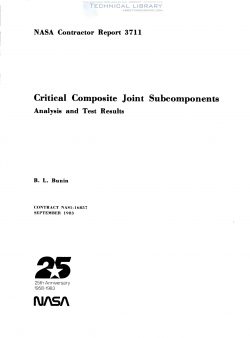NASA-CR-3711
- Version
- 189 Downloads
- 63.44 MB File Size
- 1 File Count
- July 30, 2017 Create Date
- July 30, 2017 Last Updated
Critical Joint Subcomponents; Analysis and Test Results

The safe and efficient use of advanced composite materials in primary aircraft
structure has become a major topic of research. The principal objective of this
investigation is to develop and demonstrate the technology for critical structural
joints of a composite wing structure that meets all the design requirements of a
1990 commercial transport aircraft.
To fulfill this objective, procedures were developed for joint design and analysis.
A series of ancillary tests were performed to characterize composite bolted joint
behavior and provide empirical data for the analysis formulas. In addition to
single—bolt tests, a series of subcomponent joint specimens were tested and the
results were compared with analytical predictions for multirow joints of the same
configurations. The agreement between test and analysis results was found to
be very good, and the A4EJ computer analysis program was established as an effective
tool for the design and analysis of multirow bolted joints in composite structures.
The work was conducted by Douglas Aircraft Company at Long Beach, California, under
contract to NASA Langley Research Center. Significant work on which this research
was based includes an earlier NASA Langley contract on small bolted coupon tests
in which the failure mechanisms and strengths for composite laminates adjacent
to bolt holes were characterized empirically (Reference l). That work, in turn,
was followed by a recent contract with the U.S. Air Force Flight Dynamics Laboratory
at Wright Patterson AFB, Ohio, in which one task was to develop the A4EJ nonlinear
computer program for load—sharing in multirow bolted joints (Reference 2).
The analysis of load transfer through mechanically fastened joints in fibrous
composite laminates must inevitably rely upon some empirically derived input
based on test results. This is so because fiber—reinforced resins do not fall
as homogeneous one—phase materials, although they are usually modeled as such, but
as heterogeneous materials with two distinct phases and an interface. As shown
in Figure l, the efficiency of real composite bolted joints lies roughly halfway
between analytical predictions based on purely elastic and perfectly plastic
behavior. Analysis based on either extreme does not come close to predicting the
strength of these single—row bolted joints, and either extreme would not be
acceptable for design purposes without some form of major modifications.
| File | Action |
|---|---|
| NASA-CR-3711 Critical Joint Subcomponents; Analysis and Test Results.pdf | Download |

Comment On This Post